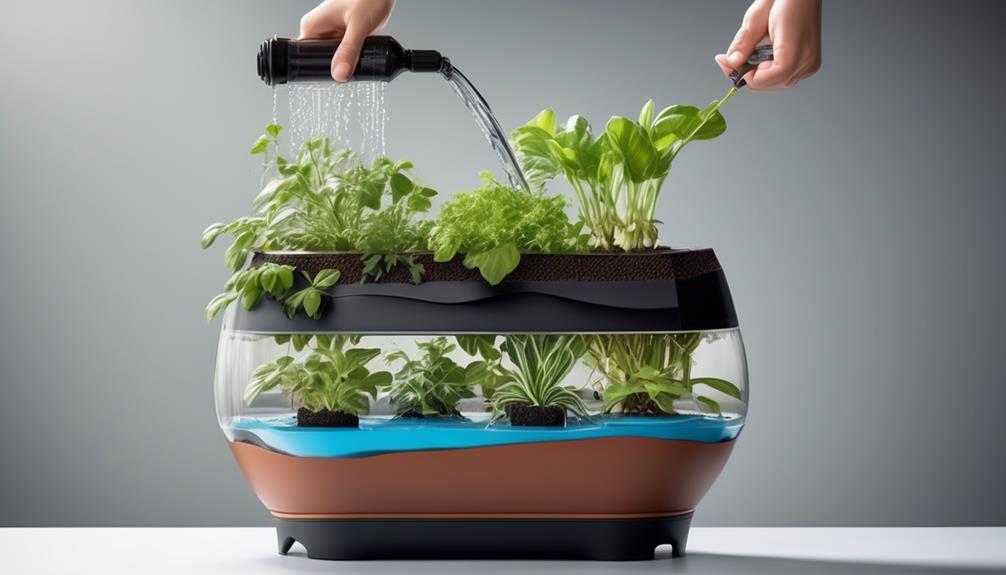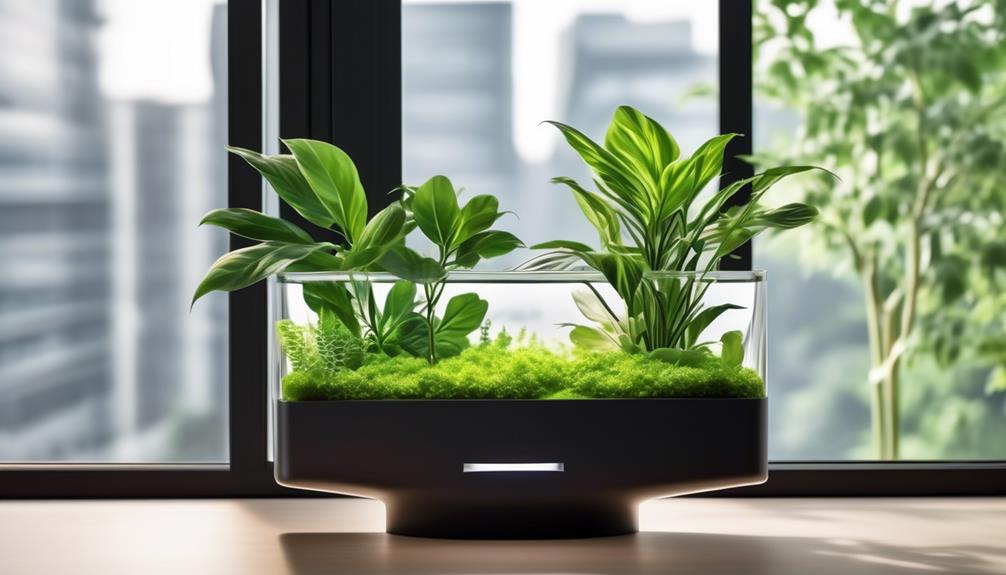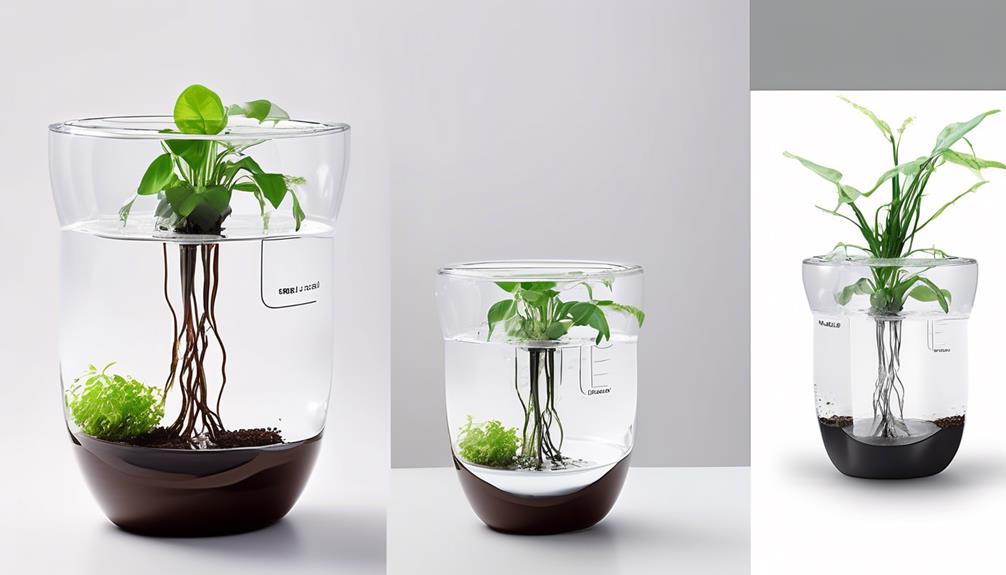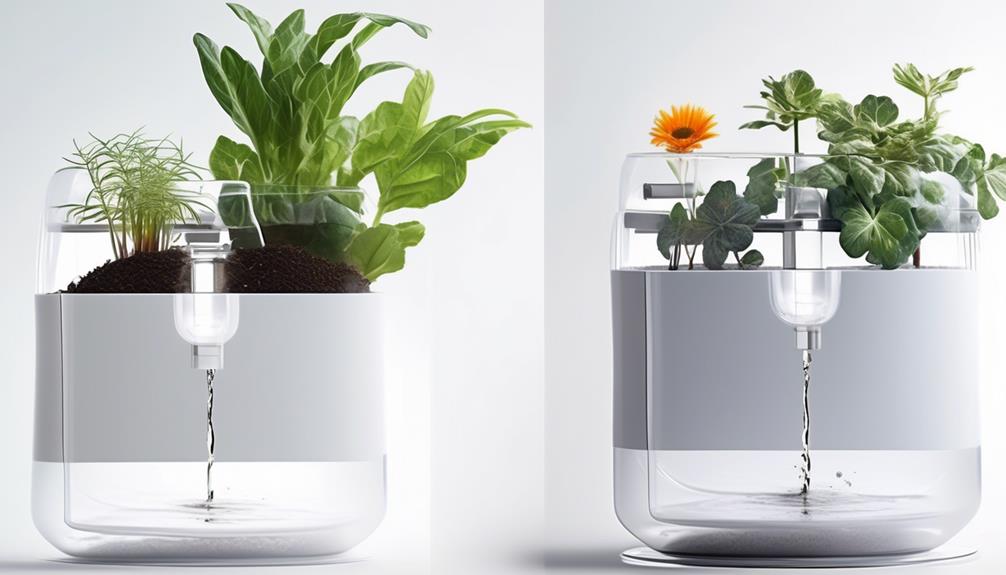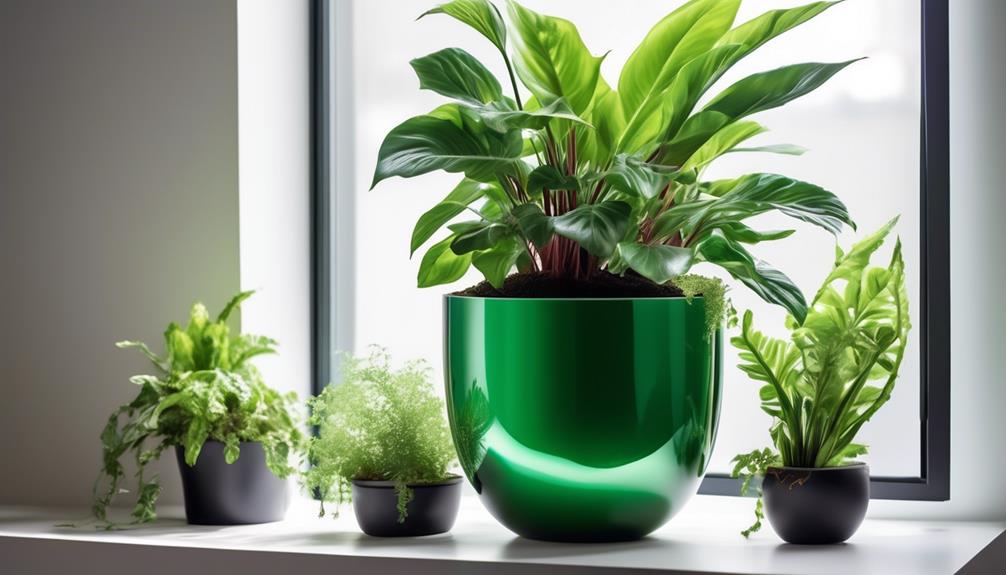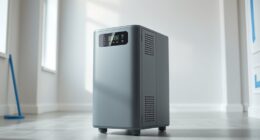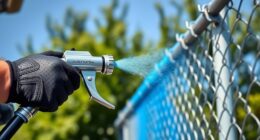You have come across the wonders of self-watering planters and their promised convenience in plant care, but do they really deliver on their claims of easy maintenance?
Well, let's just say there's more to it than simply filling up the reservoir and forgetting about it.
As we explore the ins and outs of planting in self-watering pots, you might be surprised by the considerations and techniques that can make all the difference in your greenery's well-being.
Stick around to uncover the secrets to successful self-watering pot planting and watch your plants thrive like never before.
Key Takeaways
- Choose the right pot size, design, and material for optimal watering frequency
- Select a potting mix with good water retention properties and essential nutrients
- Use plants suitable for the pot size and environment
- Regularly monitor and adjust water levels and sunlight exposure
Choosing the Right Self-Watering Pot
When selecting a self-watering pot, it's crucial to consider the material, size, and design to ensure optimal plant growth and water efficiency.
Pot size plays a vital role in plant health as it determines the amount of soil available for roots and the reservoir capacity for water. Larger pots provide more room for plant roots to spread and access water, reducing the frequency of watering. However, it's essential to match the pot size with the plant's needs, as an excessively large pot can lead to overwatering, causing root rot. Conversely, a pot that's too small may require frequent refilling of the reservoir, leading to inconsistent watering and potential stress for the plant.
In addition to pot size, the design of the self-watering pot influences watering frequency. Pots with a larger water reservoir require less frequent refilling, providing a more stable water supply for the plant. Moreover, the material of the pot can also impact watering frequency, as some materials may absorb or release water at different rates.
Considering these factors when choosing a self-watering pot is essential for maintaining optimal plant health and efficient water use.
Selecting the Ideal Potting Mix
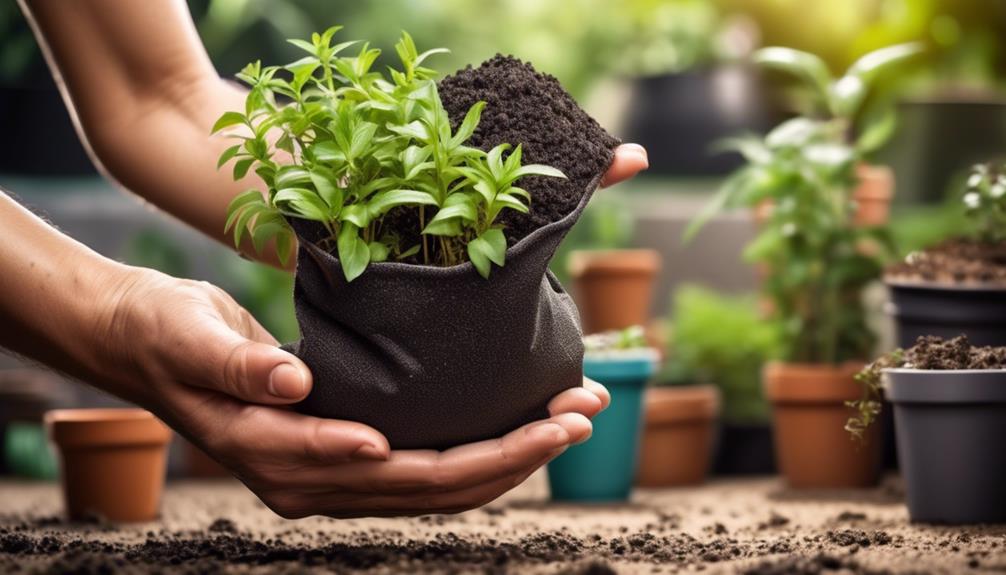
Selecting the ideal potting mix is crucial for ensuring proper plant nutrition and growth in self-watering pots. The potting mix not only provides physical support for the plant but also serves as a reservoir for water and nutrients.
When choosing a potting mix for self-watering pots, several factors should be considered to ensure the best environment for plant growth.
- Watering Frequency: The potting mix should have good water retention properties to maintain consistent moisture levels, reducing the frequency of watering. This is essential for the success of self-watering pots as it helps to prevent both overwatering and underwatering.
- Soil Composition: A high-quality potting mix for self-watering pots should consist of a well-balanced blend of organic materials such as peat moss, coconut coir, or compost, along with inorganic materials like perlite or vermiculite. This combination allows for optimal air circulation and water drainage, promoting healthy root development and preventing waterlogged conditions.
- Nutrient Content: The potting mix should also contain essential nutrients for plant growth, such as nitrogen, phosphorus, and potassium, as well as micronutrients like calcium, magnesium, and iron. These nutrients will support the plant's overall health and productivity.
- pH Levels: The ideal potting mix should have a balanced pH level suitable for the specific plants being grown, promoting nutrient uptake and preventing nutrient deficiencies.
Planting the Greenery in the Pot
We will now proceed with planting the greenery in the pot, ensuring proper positioning and preparation for optimal growth and development.
First, we must prepare the soil. Choose a high-quality potting mix that's well-draining and rich in organic matter. This will provide essential nutrients and aeration for the plant's roots. Fill the self-watering pot with the potting mix, leaving enough space for the root ball of the selected plant.
When it comes to plant selection, consider the specific needs of the greenery you want to grow. Select plants that are suitable for the size of the pot and the environment they'll be placed in. Ensure that the chosen greenery will thrive in the available light conditions and climate.
Now, carefully remove the plant from its nursery container, being mindful not to disturb the roots excessively. Gently place the plant into the prepared pot, ensuring that it's positioned at the correct depth. Fill in any gaps with additional potting mix, pressing lightly to secure the plant in place.
Adding Water to the Self-Watering System
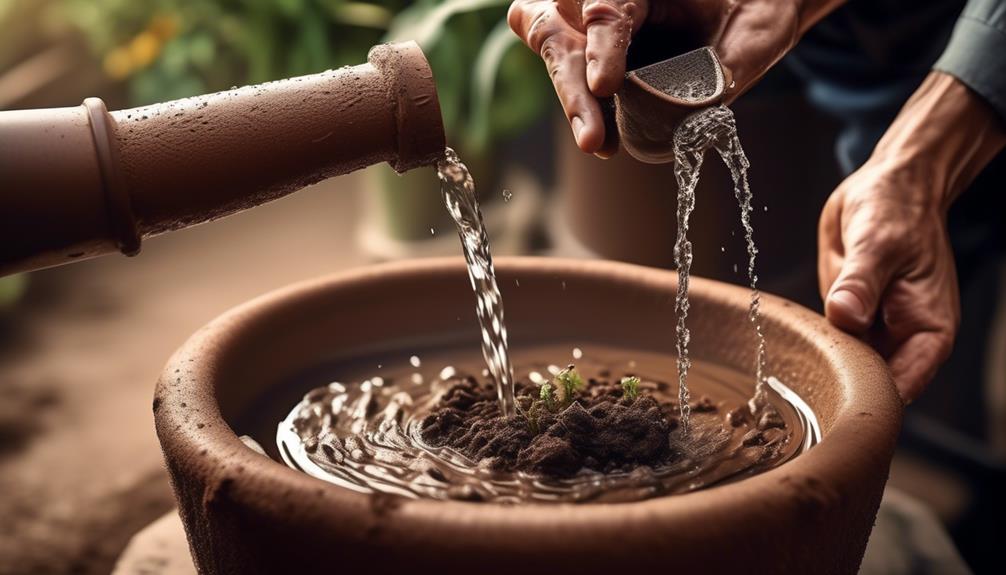
How can water be effectively added to the self-watering system to ensure proper hydration and maintenance of the planted greenery? Proper watering is essential for the well-being of plants in self-watering pots. Here are some key points to consider:
- Watering Frequency: It's crucial to understand the specific watering needs of the plants in your self-watering pots. Different plants have different water requirements, so it's important to research and understand the watering needs of the specific plants you have.
- Watering Techniques: When adding water to the self-watering system, it's important to do so in a manner that allows the potting mix to absorb the water effectively. Pour the water into the designated reservoir, ensuring that it's distributed evenly. Avoid overfilling, as this can lead to waterlogging and potential root rot.
- Monitoring Moisture Levels: Regularly check the moisture levels in the potting mix to ensure that the plants are receiving adequate water. This can be done by observing the soil moisture or by using a moisture meter.
- Adjusting for Environmental Factors: Factors such as temperature, humidity, and sunlight can affect the watering needs of the plants. Be mindful of these factors and adjust the watering frequency as needed to maintain optimal growing conditions.
Monitoring and Adjusting Water Levels
As we start discussing the monitoring and adjusting of water levels in self-watering pots, it's crucial to understand the significance of water level indicators.
We'll also need to learn the process of adjusting the watering system to ensure optimal moisture levels for the plants.
Additionally, we'll emphasize the importance of regularly checking the moisture levels to maintain a healthy growing environment.
Water Level Indicators
To effectively monitor and adjust water levels in self-watering pots, the use of water level indicators is essential for maintaining optimal plant hydration. Water level indicators provide accurate and real-time information about the water levels in the reservoir, ensuring that the plants receive the right amount of water they need.
Here are some key benefits of using water level indicators:
- Precision: Water level indicators allow for precise monitoring of water levels, preventing overwatering or underwatering.
- Convenience: They make it easy to visually check the water levels without the need to constantly lift the pot or remove the soil.
- Optimization: By providing visual cues, water level indicators help optimize watering frequency, leading to improved plant hydration.
- Maintenance: They aid in the maintenance of the self-watering system, ensuring its proper functioning and the overall health of the plants.
Adjusting Watering System
When adjusting the watering system in self-watering pots, it's crucial to monitor and carefully adjust the water levels to ensure optimal plant hydration. To optimize water distribution, adjusting timing settings is essential.
Begin by observing the plant's water usage patterns and adjusting the timing settings on the watering system accordingly. This may involve increasing or decreasing the frequency and duration of watering cycles based on environmental conditions and plant needs.
It's important to regularly check the soil moisture to ensure that it remains within the ideal range. Additionally, adjusting the timing settings to coincide with the plant's natural growth cycles can further enhance its health and vitality.
Checking Moisture Regularly
Monitoring and adjusting water levels in self-watering pots is an essential practice that allows us to maintain optimal plant hydration and growth, building on our previous focus on adjusting the watering system. To ensure the proper moisture levels, we must regularly check the soil moisture and adjust the watering frequency as needed.
Here are crucial steps to consider:
- Use a soil moisture meter to regularly check the moisture level in the potting mix.
- Adjust the watering frequency based on the soil moisture readings, ensuring the soil remains consistently moist but not waterlogged.
- Monitor the plant's response to the watering schedule, making adjustments if the plant shows signs of overwatering or underwatering.
- Consider environmental factors such as temperature and humidity levels, as they can affect the soil moisture and watering needs.
Providing Adequate Sunlight and Care
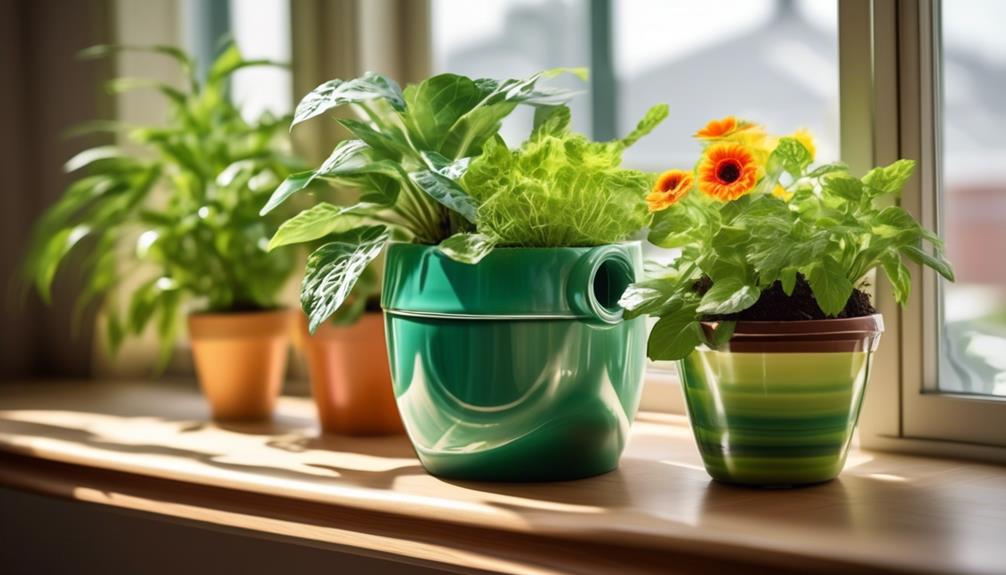
First, we need to ensure our self-watering pots are placed in an area that receives adequate sunlight for plant growth.
We'll also discuss the proper care techniques necessary to maintain healthy and thriving plants.
Additionally, we'll explore the importance of monitoring and adjusting the water levels in these pots to complement the sunlight and care provided.
Sunlight for Plant Growth
To ensure optimal growth, it's crucial to place the self-watering pots in a location that receives adequate sunlight, typically at least six hours of direct sunlight per day, and to monitor the plant's condition regularly. Adequate sunlight is essential for the photosynthesis process, enabling the plant to produce its own food and thrive. Here are some key points to consider:
- Sunlight Intensity: Ensure the plants receive the right intensity of sunlight for their specific species.
- Sunlight Duration: Monitor and ensure the plants receive a minimum of six hours of direct sunlight each day.
- Sunlight Exposure: Rotate the self-watering pots regularly to ensure all sides of the plant receive equal sunlight exposure.
- Indoor Lighting: If sunlight is limited, consider using artificial grow lights to supplement the plant's light requirements.
Proper Care Techniques
Ensuring adequate sunlight exposure is a critical component of proper care techniques for plants in self-watering pots. In addition to sunlight, maintaining the right watering frequency and soil moisture is essential for the overall health of the plants. Here's a detailed guide to help you properly care for your plants in self-watering pots:
| Watering Frequency | Soil Moisture |
|---|---|
| Check the soil moisture using a moisture meter or by inserting your finger into the soil. Water the plants when the top inch of the soil feels dry. | Ensure the self-watering system has an adequate water supply. Monitor the soil moisture regularly and adjust the water level as needed to maintain consistent moisture. |
Troubleshooting Common Issues
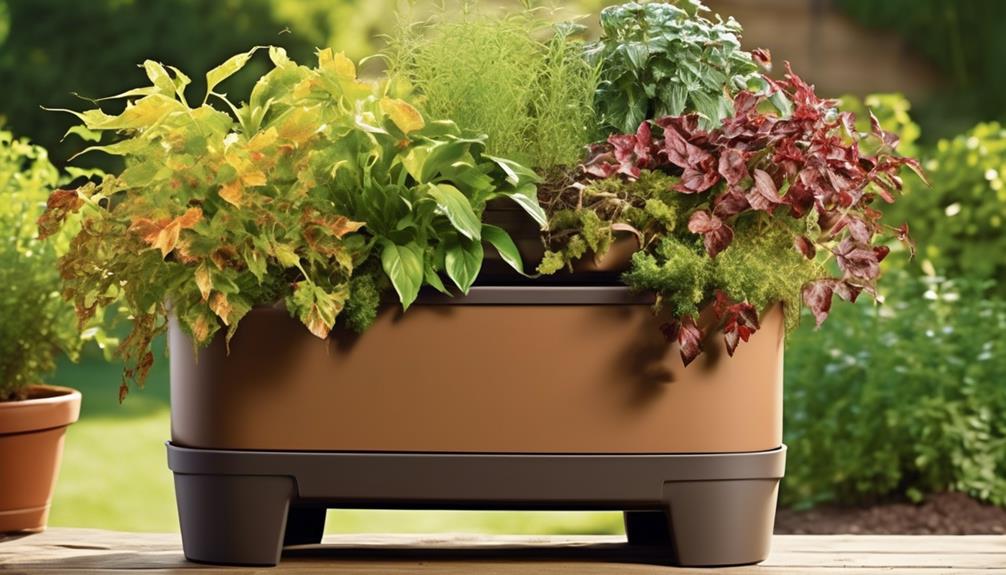
After assessing the self watering pot system, we identified that the most common issue is inadequate water supply due to clogged or blocked water channels. This can lead to the plants not receiving enough water, which can impact their growth and health.
Here are some troubleshooting tips to address this issue:
- Clearing Obstructions: Inspect the water channels and make sure they're free from debris or mineral buildup.
- Adjusting Water Levels: Check that the water reservoir is filled to the appropriate level, ensuring a steady supply of water to the plants.
- Cleaning and Maintenance: Regularly clean and maintain the self watering pot system to prevent blockages and ensure proper functioning.
- Monitoring Plant Health: Keep an eye on the overall health and growth of the plants to detect any signs of water inadequacy.
Frequently Asked Questions
Can Self-Watering Pots Be Used for All Types of Plants, or Are There Specific Plants That Work Best With This Type of System?
Self-watering pots can be used for a wide variety of plants, but some plants are better suited for this system. The best plants for self-watering pots are those that prefer consistently moist soil, like ferns, peace lilies, and spider plants.
These pots prevent overwatering and underwatering by providing a steady water supply, making them ideal for busy plant owners. It's important to choose specific plants that work well with this type of system to ensure optimal growth.
How Often Should the Water Reservoir in the Self-Watering Pot Be Refilled, and Are There Any Tips for Preventing Overwatering or Underwatering?
We've found that the water reservoir in self-watering pots should be refilled based on the plant's water needs. To prevent overwatering, regularly check the soil moisture and adjust the watering frequency accordingly.
Conversely, to prevent underwatering, ensure the reservoir is adequately filled. It's crucial to understand the specific watering requirements of your plant to maintain optimal moisture levels.
Monitoring the soil moisture and adjusting the reservoir refill frequency accordingly is essential.
Are There Any Special Considerations for Using Self-Watering Pots in Extreme Temperatures, Such as Very Hot or Very Cold Weather?
In extreme temperatures, self-watering pots can be beneficial. However, certain materials like plastic may degrade. The reservoir's water may evaporate faster in hot weather, requiring more frequent refills. In cold climates, water in the reservoir could freeze, disrupting the watering system.
Despite these drawbacks, self-watering pots still provide consistent moisture levels. It's essential to consider the pot material and monitor water levels closely to ensure optimal performance in extreme temperatures.
Can Self-Watering Pots Be Used for Indoor Plants, and if So, What Are the Best Placement and Care Practices for Indoor Use?
We find that self-watering pots are suitable for indoor plants, offering an excellent alternative to traditional watering methods.
The best indoor plants for self-watering pots include peace lilies, spider plants, and pothos.
Ideal placement is in well-lit areas away from direct sunlight.
To prevent overwatering, water the plants once every 1-2 weeks, depending on the specific plant's needs.
This method ensures optimal care and growth for indoor plants.
Are There Any Maintenance or Cleaning Tips for Keeping the Self-Watering System in the Pot Functioning Properly Over Time?
Maintenance tips for self-watering pots are crucial for optimal functioning.
Regular cleaning of the watering system is essential to prevent clogging and ensure proper water flow. We recommend using a mild cleaning solution and a brush to remove any mineral deposits or algae buildup.
Additionally, inspecting the system for any wear or damage and replacing any worn parts will help maintain the efficiency of the self-watering mechanism.
Does the Placement of Water in a Self Watering Pot Affect the Planting Process?
The placement of water in a self-watering pot is crucial for the planting process. The water reservoir at the bottom of the pot provides a constant supply of moisture to the soil, ensuring the plant receives consistent hydration. Properly positioning the watering self watering pot can help maintain optimal moisture levels for healthy plant growth.
Conclusion
In conclusion, self-watering pots offer a convenient and efficient way to keep your greenery hydrated.
With the right pot, potting mix, and proper care, you can create a self-sustaining environment for your plants to thrive.
By monitoring and adjusting water levels, providing adequate sunlight, and troubleshooting any issues, you can ensure that your self-watering pots will keep your plants healthy and vibrant, like a well-oiled machine.


